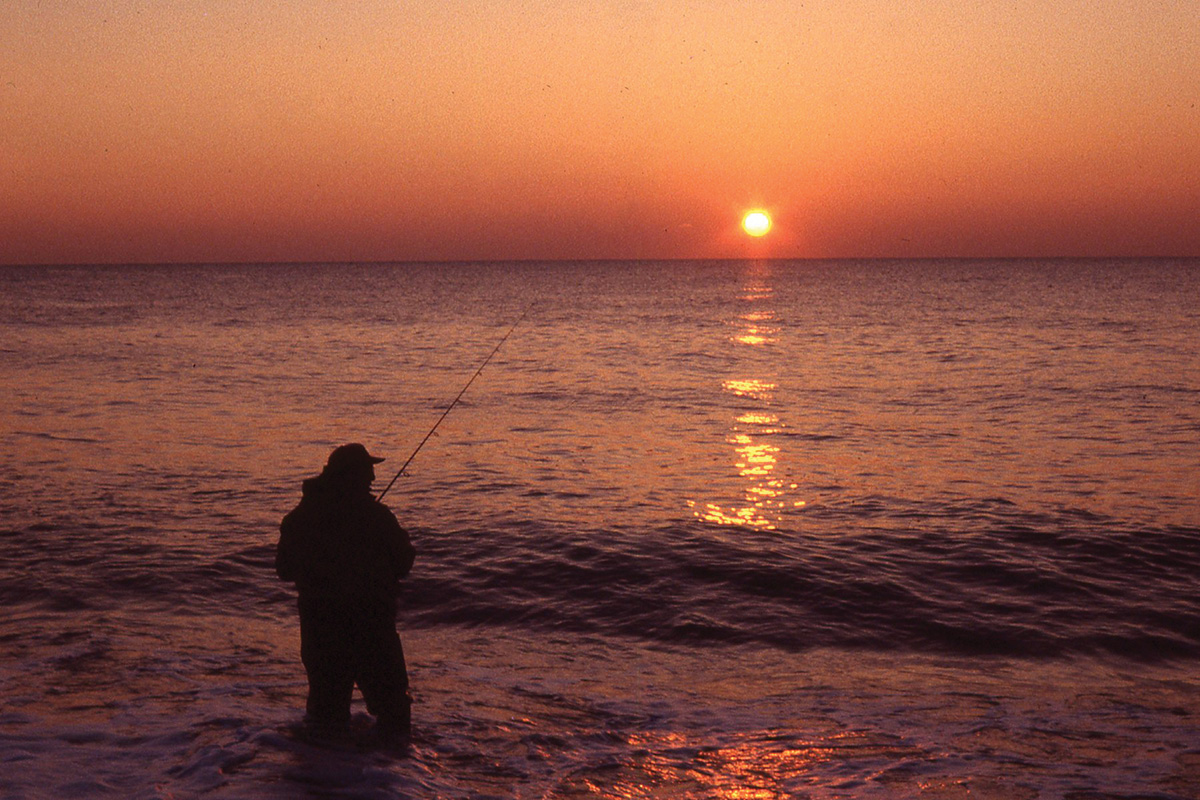
After a blustery winter filled with snow, ice and wind, there’s nothing I enjoy more than heading to Jersey and Delaware beaches as the days lengthen, and the sun shines bright. This combination augurs well for recreational fishermen, as striped bass that have been wintering in bays and rivers from the Chesapeake Bay on north to New Jersey will have spawned and begin their trek to summer quarters.
This combination is something I look forward to, as it’s an excellent opportunity to head to my favorite sand beaches and target the magnificent striped bass, a species I first caught fully 70 years ago, and to this day I continue to target as one of my favorites.
Unlike late spring and early autumn when stripers are more apt to chase schools of forage species on the surface and aggressively swat lures, the early season run stripers are most often hugging the bottom, where they encounter a variety of food as they swim within easy casting distance of the beach.
Thus, the nice part of spring fishing is it’s relaxing, as most often you’ll be fishing a natural bait on the bottom, and can bring along a folding beach chair and sit and relax as you wait for the bass to find the bait you’ve cast to their favorite haunts.
Early Season Rigging
I’ll often bring a pair of outfits, casting one baited rig out and placing it in a sand spike and keeping a second on-hand for tossing small lures occasionally (a little exercise for the late spring action.) A pair of medium action 8-foot rods offer the punch when using 4-ounce pyramid sinkers or lighter weight lures alike.
As to terminal rigging there I’ve found a couple of basic rigs that work nicely with most surf conditions. I’ve often used a simple rig composed of a three-way swivel tied directly to the line, with a pyramid style sinker snapped to the swivel. To the remaining eye of the swivel tie a 3-foot long piece of 30- or 40-pound test monofilament or fluorocarbon leader material. Snell a 6/0 or 7/0 baitholder style hook to one end of the leader and then slip a cork float onto the leader, placing it approximately a foot from the hook. Then tie the leader to the remaining eye of the swivel. When baited up and cast out the float on the leader will suspend the bait approximately a foot to a foot-and-half off the bottom. The float suspends the bait in an enticing manner, and within easy reach of a hungry striper searching for a meal.
Another rig option, consisting of a pair of hooks, is easy to tie and also effective, as it places one baited hook directly on the bottom and a second hook suspended off the bottom. Begin with a 4-foot long piece of leader material and tie one end directly to an end snap, onto which you’ll place the sinker. Then tie a dropper loop about a foot from the sinker, and a second dropper loop about 2 feet from the first; tie a barrel swivel at the end of the leader, onto which you’ll also tie your line. To complete the rig slip an 18-inch length of leader material with an end loop onto the dropper loop nearest the sinker. Then slip another snelled hook with a small cork float approximately 6 inches from the hook onto the remaining dropper loop.
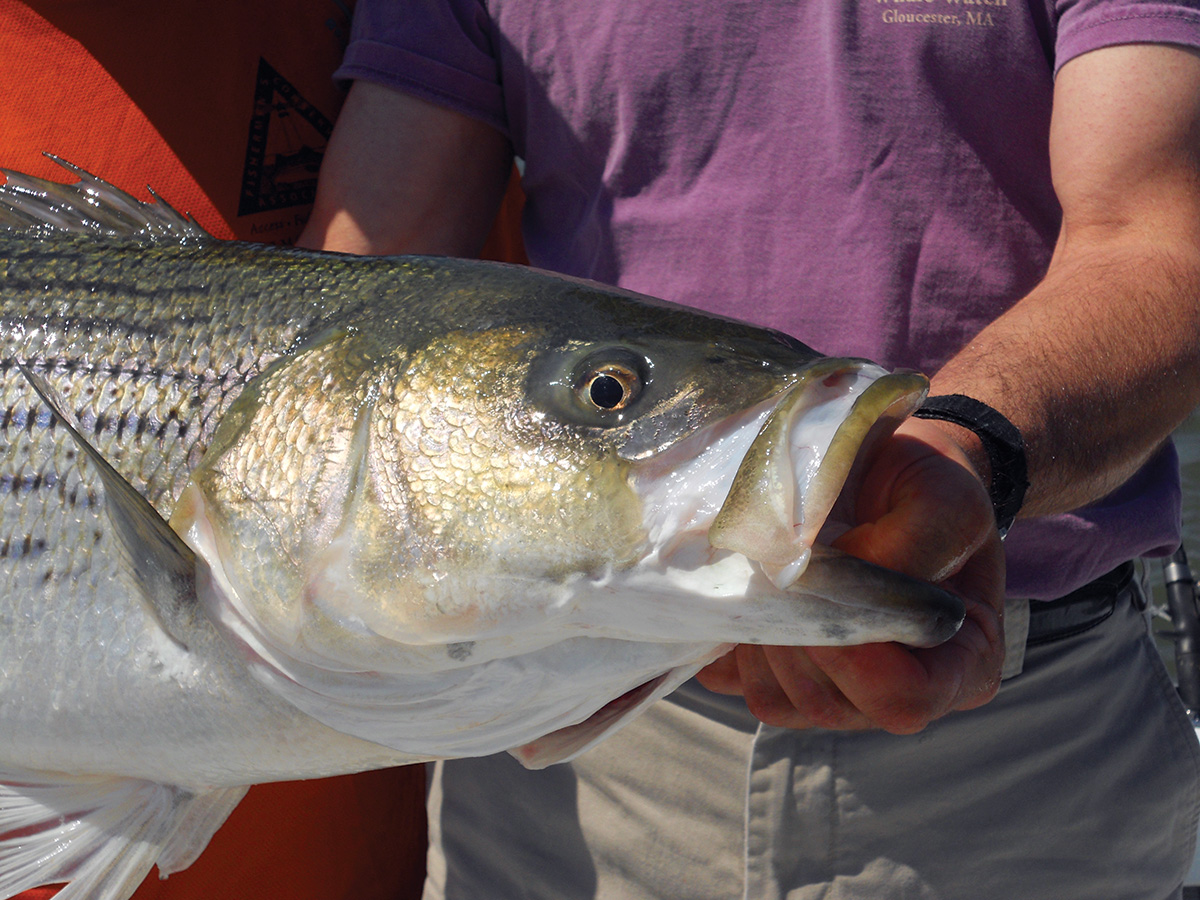
Soft Bait Selection
When baited up and cast out, the rig will rest flat on the bottom, as you’re casting from the surf. This results in one hook bait resting directly on the bottom. The second baited hook with its small float will be suspended a foot or so off the bottom, presenting the bait in an enticing matter as it flutters about in the current just off the sand bottom.
There are a variety of natural baits that may be used, as the stripers are browsing along the bottom as they search for a meal and will readily take an enticing treat. I tend to use large surf clams as bait, which I often purchase weeks before leaving for the fishing grounds. I shuck the clams, then place the soft meat into a heavy salt brine solution. The brine hardens and preserves the clam meat, which I place in small plastic jars, and it keeps well for months. Clam baits prepared in this manner are firm and don’t easily slip from the hook as does fresh clam meat.
Close behind are baits of fresh fish such as bunker, mackerel or herring. The baits can be cut into chunks 2 to 4 inches in diameter and stay on the hook quite well. I’ve also scored with small whole squid. Then of course we have sea worms. Bloodworms and sandworms are popular, particularly along the sedges and sod banks in March, but they’re delicate and quite easily ripped from the hook while casting. While generally not available commercially, I caught my first striper on a tape worm. I’ve dug many of them from the sand of Jersey bays and rivers, and they’re a fine bait too.
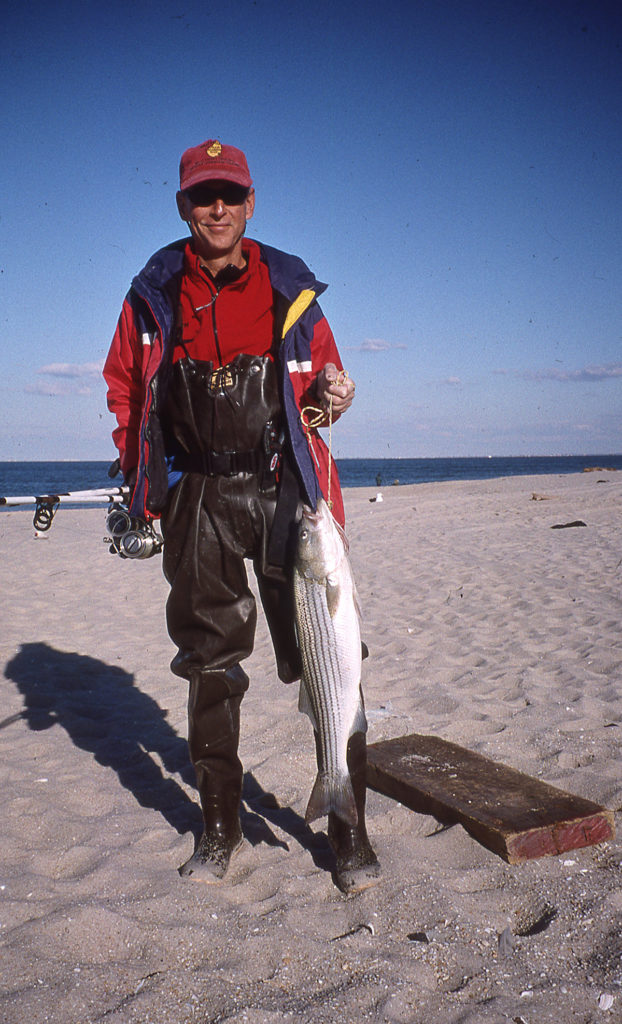
Studying Your Beach
Our Jersey and Delaware beaches are beautiful and the majority have sandbar formations running parallel to the beach and between a hundred to a couple of hundred feet from the sand beach. Waves crash onto and over the outer bar, move onto the beach through a shallow trough located inside the bar. As the water begins to recede it tends to move either north or south parallel to the beach, exiting through a trough most often located between bars.
I make mention of this configuration as often it’s not readily visible, and it’s confusing to some as to why in some spots the current moves north and just a short distance away it’s moving south. This is because it’s following the path of least resistance. By understanding this configuration you’ll learn to try to cast across the bar formation if it’s within casting range or to concentrate your efforts in the deep water of the troughs between the bars, not the shallows inside the bars. This is where the water rushes seaward after coming across the bars, and where the turbulence often exposes food, and the stripers move across this bottom being churned by the current.
There are also many sections of coast where the surf, particularly between rock jetties, doesn’t have sandbars. Instead the bottom just gently slopes seaward. However, there are spots where there is a steep drop-off, where from the spot you’re standing along the edge of the water the depth just a few feet seaward may be several feet deep. This is particularly true on the northernmost beaches of Sandy Hook, where the swift tides coming and going into the bays wash away the sand and leave almost a vertical drop-off, requiring caution to ensure you’re safe while fishing. Deep drop-offs are also encountered on the beaches adjacent to Shark and Manasquan Inlets.
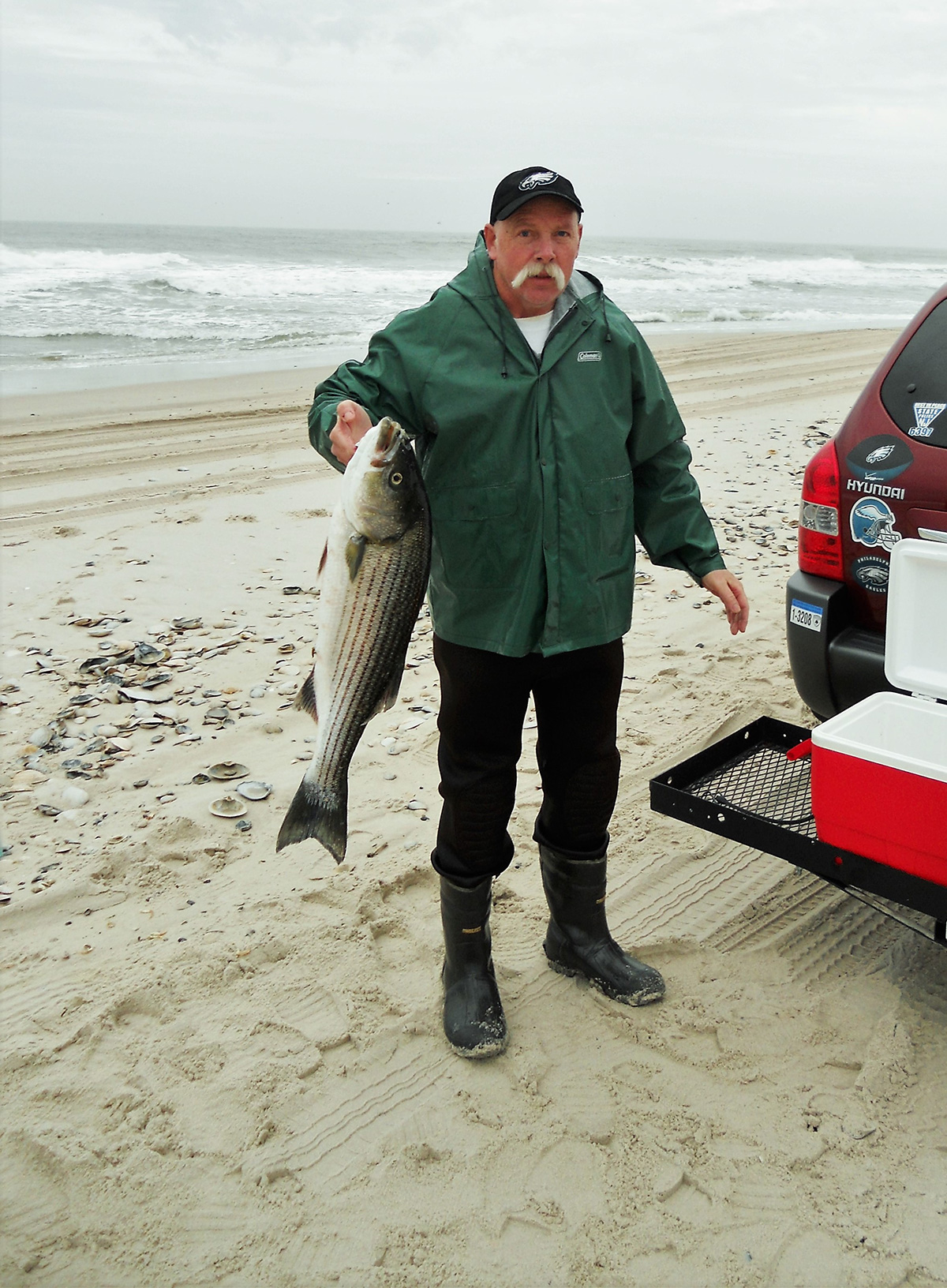
Deadstick & Move
I make it a point to visit my favorite haunts at low tide as soon as the weather is moderate. This enables me to see the configurations developed over the winter and plan accordingly as I head to the surf to fish. During the colder stretches of March when action out front is slow, it’s still a terrific time to do a little recon for later trips, just to see how winter weather may have impacted your favorite spot.
Once I’ve made my first cast and the bait is resting on the bottom I’ll check my reel’s drag, making certain it contains sufficient pressure to hook a striper as it inhales the bait and begins to swim away. It’s one thing that some casters forget to do after their gear has been stowed away through January and February. Take care not to have too tight a drag, as I’ve seen anglers’ rods literally dragged from the sand spike and into the crashing surf by a hefty bass.
Towards this end, my last bit of advice is that you should try fishing the outfits in sand spikes, as many of the bass will hook themselves. If you prefer to hold an outfit, take care to hesitate when you feel a striper pick up your bait, and lower your rod tip as it begins to move off with the bait it’s just inhaled. Give it a chance to get the bait deep where your hook can penetrate. Too fast a strike on your part will often result in a missed hookup.
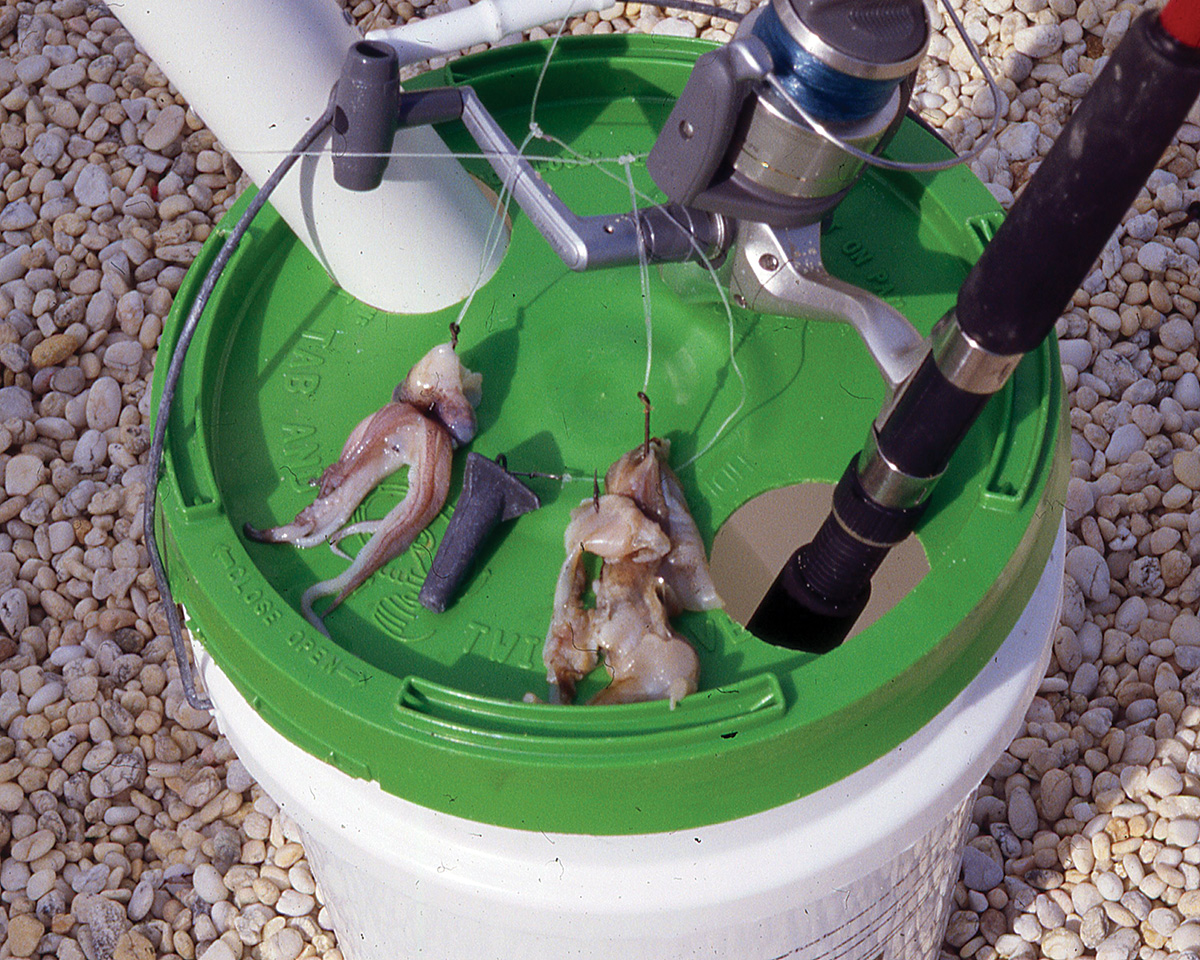
The key to scoring with migrating stripers this spring really comes down to patience. Pick your days, so you’re on the beach with a moderate, clean surf. I’ll often watch my rod in the sand spike as I work a second rod outfitted with a small lure and teaser combo. Casting small soft plastic lures resembling forage species and eels, or a deep-running swimming plug or bucktail jig with pork rind works well, with an enticing 3- to 4-inch long teaser, like a holographic sand eel or a bucktail and feather combo in brown or silver that flutters ahead of the primary lure is a combo that will serve you well.
See you on the beach!




